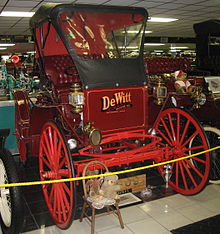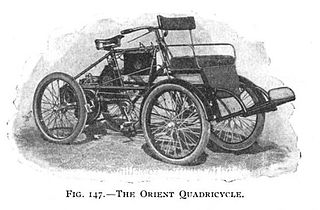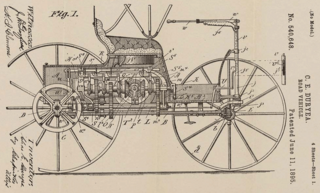
A high wheeler is a car which uses large diameter wheels that are similar to those used by horse-drawn vehicles. [1] These cars were produced until about 1915, [2] predominantly in the United States.

A high wheeler is a car which uses large diameter wheels that are similar to those used by horse-drawn vehicles. [1] These cars were produced until about 1915, [2] predominantly in the United States.
High wheelers were derived from horse-drawn wagons, [3] and often were conversions of these. Similarly to these wagons, they often had wood-spoke wheels, suspensions, and boxy wooden bodies.
The large-diameter slender wheels provided ample ground clearance on the primitive roads of the late 19th century, and frequently had solid rubber tires. [3]
These cars were produced in many body styles. The most common were the motorized wagon (utility vehicle) [4] [5] runabout, roadster [6] [7] and buggy, [8] [9] some with detachable tonneaus.
Before gasoline engines became widely available, high wheelers were powered by electric motors or steam engines.
The decline of the high wheeler began when standard automobiles became more sophisticated and inexpensive. The end came with the popularity of the Ford Model T. [10] The last high wheelers were built around 1915. [2]
The following companies produced high-wheeler cars:
* Companies which also produced cars other than high wheelers

A wagon or waggon is a heavy four-wheeled vehicle pulled by draught animals or on occasion by humans, used for transporting goods, commodities, agricultural materials, supplies and sometimes people.

Horseless carriage is an early name for the motor car or automobile. Prior to the invention of the motor car, carriages were usually pulled by animals, typically horses. The term can be compared to other transitional terms, such as wireless phone. These are cases in which a new technology is compared to an older one by describing what the new one does not have.

The Brass Era is an American term for the early period of automotive manufacturing, named for the prominent brass fittings used during this time for such features as lights and radiators. It is generally considered to encompass 1896 through 1915, a time when cars were often referred to as horseless carriages.

Quadricycle refers to vehicles with four wheels.

The Duryea Motor Wagon Company, established in 1895 in Springfield, Massachusetts, was the first American firm to build gasoline automobiles.

The Duryea Motor Wagon was among the first standardized automobiles and among the first powered by gasoline. Fifteen examples were built by the Duryea Motor Wagon Company of Chicopee, Massachusetts, between 1893 and 1896. Their enterprise followed the first commercially available automobile which was patented by Karl Benz on January 29, 1886, and put into production in 1888.

Charles Edgar Duryea was an American engineer. He was the engineer of the first-ever working American gasoline-powered car and co-founder of Duryea Motor Wagon Company. He was born near Canton, Illinois, a son of George Washington Duryea and Louisa Melvina Turner, and died in Philadelphia, Pennsylvania, but spent most of his life working in Springfield, Massachusetts. It was in Springfield that Charles and his brother, Frank, produced and road-tested America’s first gasoline-powered car.

Development of the automobile started in 1672 with the invention of the first steam-powered vehicle, which led to the creation of the first steam-powered automobile capable of human transportation, built by Nicolas-Joseph Cugnot in 1769. Inventors began to branch out at the start of the 19th century, creating the de Rivas engine, one of the first internal combustion engines, and an early electric motor. Samuel Brown later tested the first industrially applied internal combustion engine in 1826.

The LuLu cyclecar was produced by the Kearns Motor Truck Company n Beavertown, Snyder County, Pennsylvania from 1914 to 1915.

James Frank Duryea and his brother Charles (1861–1938) invented the first gasoline-powered automobile in America.

The Union automobile was a vehicle manufactured by the Union Automobile Company from 1902 until 1905. It was designed by John William Lambert, who had developed the three-wheel Buckeye gasoline buggy in 1891. Over the next decade, Lambert substantially refined the vehicle, with modifications including an additional wheel, a more powerful engine, and a new transmission system. The Union Automobile Company was formed as a subsidiary of Lambert's Buckeye Manufacturing Company solely to manufacture the Union, which took its name from Union City, Indiana, the city where it was built and which endorsed its production. In total, the company built over three hundred Union automobiles, before development shifted to the Lambert automobile, the Union's successor.

Schacht was an American marque of automobiles and High-wheelers from 1904 to 1913, in Cincinnati, Ohio. The Schacht Manufacturing Company, later renamed Schacht Motor Car Company produced over 9,000 automobiles. The company was reorganized as the G.A. Schacht Motor Truck Company in 1914 and production of trucks and fire trucks continued until 1938.

Lincoln Motor Car Works was an automobile company in Chicago, Illinois. It produced cars for Sears Roebuck from 1908 until 1912.
The Success Automobile Manufacturing Company was a brass era United States automobile manufacturer, located at 532 De Ballviere Avenue, St. Louis, Missouri, in 1906.

Hatfield Motor Vehicle Company was a pioneer brass era American automobile company, built in Miamisburg, Ohio, in 1907 and 1908.

The Buckeye gasoline buggy, also known as the Lambert gasoline buggy, was an 1891 gasoline automobile, the first made in the United States. It was also the first automobile made available for sale in the United States. It was initially a three-wheel horseless carriage, propelled by an internal combustion gasoline engine; it was later developed into a four-wheel automobile with a gearless transmission, and mass-produced during the first part of the twentieth century. The platform was later expanded into a line of trucks and fire engines.
This is a chronological index for the start year for motor vehicle brands. For manufacturers that went on to produce many models, it represents the start date of the whole brand; for the others, it usually represents the date of appearance of the main model that was produced.
The International Harvester Auto-Buggy is a two-cylinder, air-cooled motor car made by International Harvester Corporation. First announced in February 1907, the Auto-Buggy was dropped from their range of products in early 1912, but the Auto Wagon continued to 1917.
Ajax Motor Vehicle Company was a now-defunct American brass era electric car manufacturer established in New York City, which operated from 1901 until 1903. It produced the Ajax Electric car. Its factory was located at 220 West 36th Street, just north of the famed Macy's Department Store in Manhattan.